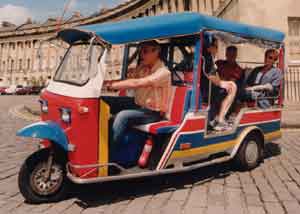
Tuk-Tuks
 These three-wheeled open-aired Made in Thailand vehicles are unique to Thailand. They have their origin in samlors, the human-pedaled vehicles which predominated before World War 2, but the addition of Japanese made small engines changed that sector, and it continues to live on. Their usage in Bangkok was common when I arrived in the mid-1990s but now there are a small fraction of them. They continue to be found in some places Bangkok, especially in tourist areas since they have some unique appeal to tourists. In small towns outside of Bangkok where there are few if any taxis, tuk-tuks are still much more common.
These three-wheeled open-aired Made in Thailand vehicles are unique to Thailand. They have their origin in samlors, the human-pedaled vehicles which predominated before World War 2, but the addition of Japanese made small engines changed that sector, and it continues to live on. Their usage in Bangkok was common when I arrived in the mid-1990s but now there are a small fraction of them. They continue to be found in some places Bangkok, especially in tourist areas since they have some unique appeal to tourists. In small towns outside of Bangkok where there are few if any taxis, tuk-tuks are still much more common.
The fare is negotiated. You may find that the fare comes out to be close to that of a taxi, for foreigners, so that the main benefit of tuk-tuks is the experience of the open air ride. The disadvantages include exposure to the pollution, the less comfortable ride and the heat if you stop at a traffic light for a long time. Of course, tuk-tuks are reasonable for only very short trips.
In tourist areas, it's common for tuk-tuks to offer sightseeing tours, which usually include stops at places where they say you can get great deals on shopping. You should decline these. The tuk-tuks get a commission, and the goods are often faked (especially jewelry) and/or overpriced. These tuk-tuk drivers are a big hassle, so you have to make clear that you are not interested in going or even talking about it.
However, most tuk-tuk drivers will just take you where you're going and not hassle you at all.
Tuk-tuk drivers are generally from very poor backgrounds and their English is worse than that of taxi drivers.
There are many tuk-tuk enthusiasts, and exports of this unique Thai invention have been taking off. For example, the British gentleman John Taylor uses them for his tour agency in England, www.TukTukTours.co.uk
 > Transportation, Maps > Tuk-Tuks
> Transportation, Maps > Tuk-Tuks
Additional, children pages of this current parent page:
Tuk-Tuks :
Copyright 1999 -
2025 by Mark Evan Prado, All Rights Reserved.
Notably, I get quickly notified of copies of tracts by the CopyScape / CopySentry automatic search engine & notifier.
Short quotes are often OK and can be approved, if there is a clear reference and web link back to my website from the quoted material, and if you send me a short message. I try to help people with good intentions, and try to help the world. Not thieves. Links back to this website are helpful for sustainable progress, thank you!
Please have honor and class by following intellectual property and internet protocols. Be a good kind of person in life.
|
Want to privately ask the Thailand Guru? Contact us.
|
|
Some of the services discussed on Thailand Guru are provided by our friendly staff in our 2 companies: |
|
|
Lucky Lion Pride Co., Ltd.
|
|
| DISCLAIMER: Although efforts have been made to ensure the information on this website was correct at the time of electronic publication, ThailandGuru and all its associates do not assume and hereby disclaim any liability to any party for any loss or damage caused by errors, omissions or misleading information resulting from negligence, accident or any other cause. If you choose to take any of this advice, it is at your own risk and no other entity's. ThailandGuru and its associates will take no responsibility. The only thing we guarantee is that our website information can take bandwidth, memory and/or disk space, at least temporarily. Guru is relative. | |
Menu: Site Map